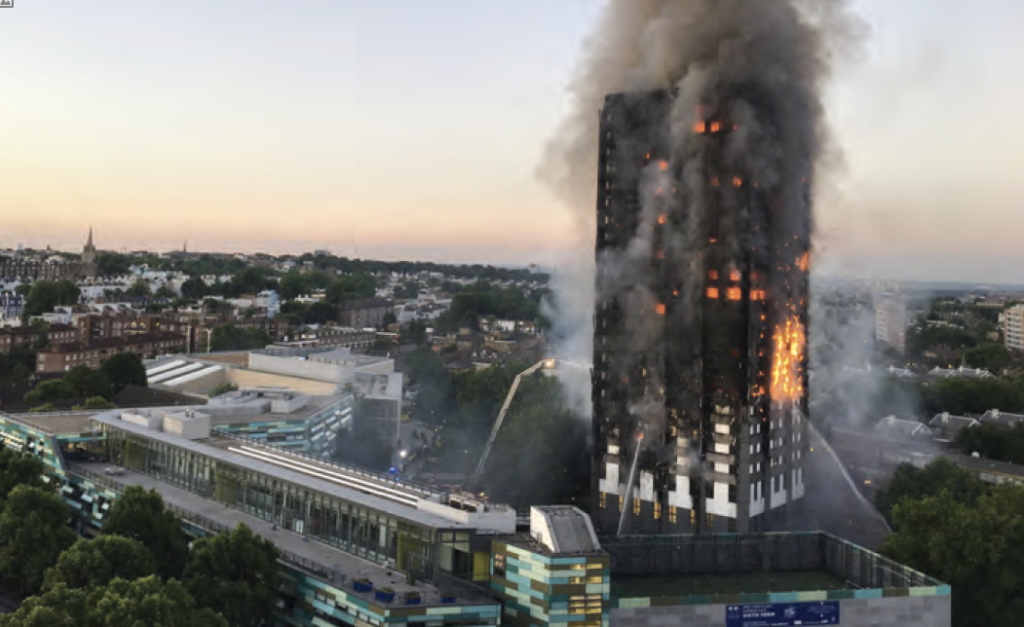The Straight Line Newsletter — Issue #6
This is the sixth issue of The Straight Line, a newsletter that appears several times throughout the year. Articles cover a broad range of topics that engage Ontario architects insured by Pro-Demnity, other OAA members – whether in practice or engaged in other businesses – and anyone with an interest in the profession.
We encourage readers to suggest topics for future issues of The Straight Line. Please send any suggestions to: mail@prodemnity.com
In This Issue

Photo: Natalie Oxford, licensed under the Creative Commons Attribution 4.0 International Licence
Grenfell Tower Fire
The devastating fire that destroyed the 24-storey Grenfell Tower, a little over a year ago, will have long-lasting and far-reaching implications for building professionals the world over.
Inspections and testing of similar projects immediately after the fire disclosed that none of those installations met the required UK fire resistance standards. As in the UK, Canadian building codes currently allow combustible components in “non-combustible” construction. Can Grenfell happen here?
In our lead article, Gordon S. Grice discusses this unfolding story – its causes, immediate effects and long-term ramifications for architects and others in the building industry.
Piling On
Architects can sometimes find themselves embroiled in multiple overlapping proceedings – civil litigation respecting a claim for damages, criminal or quasi-criminal charges related to breach of regulation or legislation, and Discipline proceedings of the OAA – all stemming from the same incident. The article explains how insurance coverage provided to Ontario architects insured under the Pro-Demnity program helps architects who find themselves in such circumstances.
— The Editor
Grenfell Tower Fire
Last June, a fire in London England destroyed an apartment tower and claimed 72 lives.
A year later, this tragedy is still in the news and is emerging as an issue of grave concern for building professionals everywhere.
The Ongoing Story
On the night of June 14, 2017, a horrendous fire engulfed a high-rise apartment building in London, England, killing 72 people and leaving hundreds homeless. The tragedy was featured on international news reels and was a topic of discussion for weeks and months afterward.
Now, over a year later, international coverage has subsided, but the far-reaching consequences of this event, locally and internationally, are becoming more and more apparent. Those of us responsible for designing and constructing tall buildings, wherever in the world they may be – as well as those who insure us – will be paying close attention.
Almost immediately after the fire, inquiries were launched into the causes and direct consequences of the tragedy. A criminal investigation was initiated by the Metropolitan Police Commissioner – an investigation that would also include the London Fire Brigade. All over the UK, authorities undertook reviews of fire safety and building regulations.
The day after the fire, Prime Minister Theresa May ordered “a full public inquiry.” This inquiry, chaired by Sir Martin Moore-Bick, is ongoing, and continuing updates, including live feeds, can be found at:
https://www.grenfelltowerinquiry.org.uk
To date, these have included reports on the outbreak of the fire, expert witness presentations, opening statements, and commemoration hearings to honour the lives lost in the fire.
In addition, a document entitled Building a Safer Future – Independent Review of Building Regulations and Fire Safety: Interim Report 1 was presented to the British Parliament in December 2017. This report, under the guidance of Dame Judith Hackitt, constituted “an Independent Review of Building Regulations and Fire Safety with a particular focus on their application to high-rise residential buildings.” (p. 5) The report proposes nothing less than a complete overhaul of existing systems.
On May 18, 2018, the Final Report 2 was released. In its Overview, it states:
The interim report identified that the current system of building regulations and fire safety is not fit for purpose and that a culture change is required to support the delivery of buildings that are safe, both now and in the future. The system failure identified in the interim report has allowed a culture of indifference to perpetuate.
The phrase “culture of indifference” casts a wide net. It includes, for example, the way that the establishment regards the financially disadvantaged, such as the Grenfell Towers tenants. Of immediate concern to the building industry, the indifference includes regulatory documents; safety compliance processes; product testing, labelling and marketing; undervaluing of residents’ concerns; and general “competence across the system”; but first, and most notably, “the roles and responsibilities of those procuring, designing, constructing and maintaining buildings.” That includes us.
Notes
- https://assets.publishing.service.gov.uk/ government/uploads/system/uploads/ attachment_data/file/668831/Independent_ Review_of_Building_Regulations_and_Fire_ Safety_web_accessible.pdf
– accessed 14 May, 2018 - https://assets.publishing.service.gov.uk/ government/uploads/system/uploads/ attachment_data/file/707785/Building_a_ Safer_Future_-_web.pdf
– accessed 18 May, 2018 - https://assets.publishing.service.gov.uk/government/uploads/system/uploads/attachment_data/file/618561/infographic-fire-statistics-england- 1516.pdf
– accessed 30 July, 2018 - https://www.nytimes.com/2017/06/14/world/europe/uk-london-fire-grenfell-tower.html
– accessed 14 May, 2018 - http://prodemnity.com/wp-content/uploads/Plan-Credit-Bulletin_March-2018.pdf, page 5
– accessed 18 May, 2018 - https://www.standard.co.uk/news/london/shock-grenfell-dossier-reveals-disastrous- refurbishment-turned-tower-into-a-tinder-box-a3814866.html
– accessed 18 May, 2018
Piling on: how architects can face overlapping civil, regulatory and disciplinary actions.
Did you know that, as members of a regulated profession, architects can find themselves facing multiple proceedings arising from the same conduct or incident?.

For example, architects may find themselves embroiled in Civil litigation claiming damages arising from alleged negligence, as well as facing charges related to contravention of Regulations such as building code or other legislation, and may be subject to Discipline proceedings of the OAA – all stemming from the same circumstances.
The architect has no control over these initiatives taken by others, nor the sequence of these multiple proceedings.
The primary interest of a professional liability insurer is the Civil action. A professional liability insurance policy typically provides the insured with a defence of this action as well as paying damages on behalf of the insured, when warranted. Nonetheless, adverse rulings in the Regulatory or Disciplinary proceedings can have a significant impact on an insurer’s ability to provide an effective defence in the Civil action.
In order to address this reality, your Pro-Demnity policy includes additional coverage in Endorsement No.1 that can assist you with necessary legal expenses. In addition, Pro-Demnity is able to defend you when there are multiple proceedings, which include:
Item 8. Defence Cost Coverage against Contravention of Statutes: The insurer will pay defence costs on your behalf where you face prosecution alleging contravention of certain statutes and regulations.
Item 10. Parallel Discipline Proceeding Defence Cost Coverage: The insurer will pay defence costs for lawyers to assist you defend a complaint referred to the OAA Discipline Committee by a member of the public, provided an insurance claim has been made against you (e.g. a Civil action) that is related to the same issue and is covered by your insurance policy.
In each of these, there is a maximum payable by Pro-Demnity of $100,000 for each action and a $200,000 aggregate; counsel must have been appointed or approved by Pro-Demnity.
Endorsement No.1 also includes provisions related to reimbursement of defence costs incurred in prosecutions for criminal negligence causing bodily harm or death in contravention of specific sections of the Criminal Code, as well as reimbursement of defence costs incurred against allegations of Intentional Acts. In each instance conditions apply, there is a maximum limit and you must be found innocent to qualify for the reimbursement.
The above is a précis of the available coverage. Full wording of the actual coverage for these issues will be found in Endorsement No.1 to the applicable Pro-Demnity Policy. Your Certificate of Insurance or Declarations Page applicable Policy and any Endorsements thereto will determine coverage. Nothing herein revises or amends the policy or your coverage.
— Pro-Demnity Staff
Our Contributor

Gordon S. Grice B.Arch, OAA, FRAIC
Gordon is a freelance communications strategist, writer, editor and illustrator. In addition to editing The Straight Line, he is also editor-in-chief of The Right Angle Journal, a quarterly that promotes an open discussion of the built environment. He is a frequent speaker and contributor to books and journals on subjects that include architectural design, drawing and writing. Over the past quarter-century, he has published more than two dozen books, as well as 81 issues of the OAA journal Perspectives. He is a recipient of the OAA Order of Da Vinci medal and a member of the Massey College Quadrangle Society.
Gordon can be contacted at:
Gordon Grice + Associates
65 Old Mill Drive, Toronto, ON M6S 4J8 Telephone: (416) 536-9191
ggrice@interlog.com
editor@therightanglejournal.com
The Straight Line is a newsletter for architects and others interested in the profession. It is published by Pro-Demnity Insurance Company to provide a forum for discussion of a broad range of issues affecting architects and their professional liability insurance.
Publisher: Pro-Demnity Insurance Company
Editor: Gordon S. Grice
Design: Finesilver Design + Communications
Address: The Straight Line c/o Pro-Demnity Insurance Company 200 Yorkland Boulevard, Suite 1200 Toronto, ON M2J 5C1
Contact: editor@pd-straightline.com
Pro-Demnity Insurance Company is a wholly owned subsidiary of the Ontario Association of Architects. Together with its predecessor the OAA Indemnity Plan, it has provided professional liability insurance to Ontario architects since 1987.
Questions related to the professional liability insurance program for Ontario architects may be directed to Pro-Demnity Insurance Company. Contact information for the various aspects of the program can be found on the Pro-Demnity website: www.prodemnity.com
Pro-Demnity Insurance Company makes no representation or warranty of any kind regarding the contents. The material presented does not establish, report or create the standard of care for Ontario architects. The information is by necessity generalized and an abridged account of the matters described. It should in no way be construed as legal or insurance advice and should not be relied on as such. Readers are cautioned to refer specific questions to their own lawyer or professional advisors. Letters appearing in the publication may be edited.
Efforts have been made to assure accuracy of any referenced material at time of publication; however, no reliance may be placed on such references. Readers must carry out their own due diligence.
This publication should not be reproduced in whole or in part in any form or by any means without written permission of Pro-Demnity Insurance Company. Please contact the publisher for permission: publisher@pd-straightline.com

